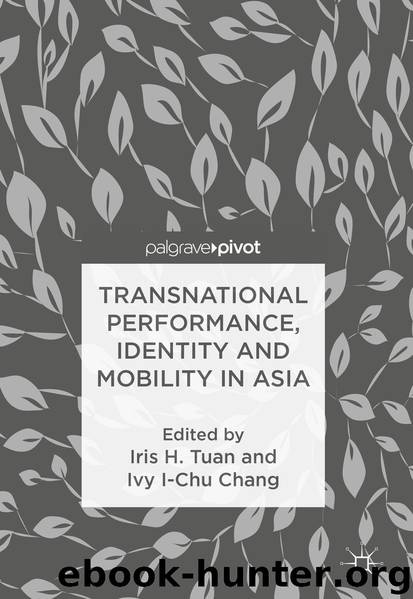Transnational Performance, Identity and Mobility in Asia by Iris H. Tuan & Ivy I-Chu Chang

Author:Iris H. Tuan & Ivy I-Chu Chang
Language: eng
Format: epub
Publisher: Springer Singapore, Singapore
Mela or Lila: A Critical Assessment
Schechner’s writings on the Ramlila of Ramnagar, often associated with his interest in interculturalism from the 1980s onward, have come under severe criticism. In Theatre and the World: Performance and the Politics of Culture, Rustom Bharucha critiques Schechner’s performance discourse about Ramlila and maintains that “religious festivals like the Ramlila cannot be subsumed within the post-modern categories of thought adopted by Schechner in his performance theory” (1993, p. 3). He goes on to point out that Schechner puts too much emphasis on the environmental-performative aspects and the social-economic functions of the festival at the expense of the spiritual (1993, p. 29). As Bharucha elaborates, “Thousands of Indians including villagers and vagrants, deprived of the basic necessities of life, turn to the rituals in the Ramlila not merely for their theatrical vitality (which should not be ignored), but for a spiritual guidance that invigorates them to face their lot in life with some resilience and courage” (1993, p 29). He concludes that Schechner’s “Ramlila is predominantly a mela, and only fleetingly, a lila” (1993, p. 29). For Bharucha , Schechner’s performance theory, for all its play and ambivalence, “upholds a methodology and a vision of the world that must be termed ethnocentric” (1993, p. 3). Moreover, his intercultural writing, Bharucha asserts, is a typical example of self-preoccupation and self-glorification, which overpowers his representation of “other” cultures “by placing them in his own ‘map’ of post-modern performance” (1993, p. 28).
When we consider Bharucha’s and Schechner’s views together, each of them seems to occupy an opposite pole of an intercultural spindle. While Bharucha polemically vies for more focused study of intra-culturalism and local culture on the one end, Schechner actively calls for more engagements in intercultural theater , theory, method, and practice as well as firmly endorses more transgressive and broad-spectrum approaches on the other. In order to witness and verify what Schechner has described in his writings, I embarked on my Ramnagar Ramlila pilgrimage and took part in the 2015 festival. Everyday around 5:00 p.m., I had to reach a specific site of the Ramlila and then followed the flow of the crowd from site to site. While sometimes I was sitting close to the theatrical action, most of the time I was edged by the crowd to the side and forced to stand by the chorus, the Ramayanis, at the very back of the performance space. As Anuradha Kapur points out in her Actors, Pilgrims, Kings and Gods: The Ramlila of Ramnagar, all the things one experiences are “the very stuff of the lila” and wherever one happens to be one sees “some aspect of the performance because the worlds of devotion, worship, business, and theatre interpenetrate” (p. 25). My own personal observation coincides with Kapur’s viewpoint for what I have witnessed testifies to the fact that the Ramnagar Ramlila is at once about rasa (the juice, taste, flavor, and savoring of emotional involvement), bhakti (devotional worship), rituals and healing, religious celebration and lila, as well as about tourism and mela.
Download
This site does not store any files on its server. We only index and link to content provided by other sites. Please contact the content providers to delete copyright contents if any and email us, we'll remove relevant links or contents immediately.
Cecilia; Or, Memoirs of an Heiress — Volume 1 by Fanny Burney(32434)
Cecilia; Or, Memoirs of an Heiress — Volume 2 by Fanny Burney(31871)
Cecilia; Or, Memoirs of an Heiress — Volume 3 by Fanny Burney(31852)
The Great Music City by Andrea Baker(31340)
We're Going to Need More Wine by Gabrielle Union(18967)
All the Missing Girls by Megan Miranda(15565)
Pimp by Iceberg Slim(14393)
Bombshells: Glamour Girls of a Lifetime by Sullivan Steve(13972)
Talking to Strangers by Malcolm Gladwell(13222)
Norse Mythology by Gaiman Neil(13204)
Fifty Shades Freed by E L James(13157)
For the Love of Europe by Rick Steves(12972)
Mindhunter: Inside the FBI's Elite Serial Crime Unit by John E. Douglas & Mark Olshaker(9200)
Crazy Rich Asians by Kevin Kwan(9167)
The Lost Art of Listening by Michael P. Nichols(7406)
Enlightenment Now: The Case for Reason, Science, Humanism, and Progress by Steven Pinker(7228)
The Four Agreements by Don Miguel Ruiz(6630)
Bad Blood by John Carreyrou(6552)
Weapons of Math Destruction by Cathy O'Neil(6142)
